A Nocturnal Journey: Exploring the Diverse Owls of France. Feathered Night Friends: The Owls that Rule French Skies. Night’s Watchmen: An Exploration of French Owls and Their Natural Habitats
Owls, these enigmatic creatures of the night, are as much a part of France’s rich biodiversity as they are of its folklore and mythology. Each owl species present in France is unique and exhibits a distinct set of characteristics and behaviors. Our guide aims to illuminate these nocturnal wonders, allowing you to identify the different owls in the French countryside and urban landscapes. We will delve into their habitats, behaviors, and role in French culture, making this a go-to reference for owl enthusiasts.
Overview of Owls in France
In France, owls are more than just a symbol of wisdom; they represent a significant part of the country’s ecology. Each species has its role in maintaining the balance of the ecosystem. Let’s look at these magnificent creatures and understand their importance.
The Owls of France: An Introduction
France is home to around ten owl species, ranging from the common Barn Owl to the elusive Boreal Owl. Each species has unique characteristics, from their physical appearance and calls to their hunting techniques and preferred habitats.
The Importance of Owls in the Ecosystem
Owls play a pivotal role in maintaining the health of the ecosystem. They are top predators, meaning they control the population of small mammals, insects, and other prey species. This regulation prevents overpopulation and ensures biodiversity. Owls also serve as an indicator species, with their presence, absence, or abundance providing valuable insights into the ecosystem’s health.
| Role of Owls | Description |
|---|---|
| Top Predators | Owls control the population of small mammals, insects, and other prey species, preventing overpopulation and promoting biodiversity. |
| Indicator Species | The presence, absence, or abundance of owls can provide insights into the overall health of an ecosystem. |
The Diverse Habitats of French Owls
From the coastal regions of Normandy to the forests of the French Alps, owls can be found in diverse habitats across France. Each species has its preferred environment, which is dictated by food availability, nesting sites, and climate. By understanding the preferred habitat of each owl species, we can more easily identify and conserve these critical areas.
| Owl Species | Preferred Habitat |
|---|---|
| Barn Owl | Farmland, open country |
| Eurasian Pygmy Owl | Dense forests, woodlands |
| Boreal Owl | Forests and Woodlands |
| Eurasian Scops Owls | Meadows, forests |
| Eurasian Eagle Owl | Grasslands, woodlands |
| Short-Eared Owl | Wetlands |
| Long-Eared Owls | Woodlands, forests |
| Little Owl | Open fields, meadows |
| Tawny Owl | Woodlands, forests |
We will explore these owl species in more detail, helping you identify and appreciate these magnificent birds of the night.
Barn Owl (Tyto alba)
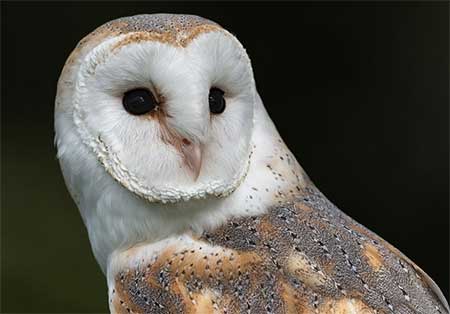 The Barn Owl, known as the “Effraie des clochers” in French, is one of the most iconic and easily recognizable owls due to its distinctive heart-shaped facial disc. This owl is not only cherished in France but is also a beloved species worldwide.
The Barn Owl, known as the “Effraie des clochers” in French, is one of the most iconic and easily recognizable owls due to its distinctive heart-shaped facial disc. This owl is not only cherished in France but is also a beloved species worldwide.
Physical Description and Identification
Barn Owls are medium-sized, typically 33-39 cm long, with a wingspan ranging from 80 to 95 cm. A unique heart-shaped face that’s white to pale tan characterizes them, contrasting with the more familiar round face of other owl species. Their eyes are dark black, and their beak is pale, horn-like.
The upperparts are golden-brown mottled with grey and white, while the underparts are pure white. There’s sexual objective dimorphism in this species, with females being slightly larger and often darker with more spotting.
| Feature | Description |
|---|---|
| Size | Medium-sized owl, typically 33-39 cm long with a wingspan ranging from 80 to 95 cm. |
| Face | Unique heart-shaped face that’s white to pale tan. |
| Eyes and Beak | Dark black eyes with a pale, horn-like beak. |
| Plumage | Golden-brown upper parts mottled with grey and white. The underparts are pure white. |
Habitat and Distribution in France
 The Barn Owl itself is one of the most beautiful and widespread birds, and its distribution in France is extensive. It can be found in such various habitats, including farmland, woodlands, marshes, and cliffs. However, it favors open habitats with some trees or structures for nesting and roosting, hence the name “Barn” Owl.
The Barn Owl itself is one of the most beautiful and widespread birds, and its distribution in France is extensive. It can be found in such various habitats, including farmland, woodlands, marshes, and cliffs. However, it favors open habitats with some trees or structures for nesting and roosting, hence the name “Barn” Owl.
They are more common in the rural parts of the country, often in old buildings, church towers, and barns. The use of nest boxes, like the ones provided by the “LPO” (Ligue pour la Protection des Oiseaux), has significantly helped in their conservation efforts.
| Habitat | Description |
|---|---|
| General | Farmland, woodlands, marshes, cliffs, and open habitats with some trees or structures. |
| Specific Locations | More common in rural parts of France, often found in old buildings, church towers, and barns. |
Behavior and Diet
 Barn Owls are primarily nocturnal but can sometimes be seen hunting during the day. They have a unique silent flight adapted for the stealthy hunting of small mammals, which forms the bulk of their diet. Common prey includes voles, mice, and rats, making them a farmer’s ally in pest control.
Barn Owls are primarily nocturnal but can sometimes be seen hunting during the day. They have a unique silent flight adapted for the stealthy hunting of small mammals, which forms the bulk of their diet. Common prey includes voles, mice, and rats, making them a farmer’s ally in pest control.
Their breeding season starts in March, and they often reuse the same comfortable nesting site year after year. Barn Owls can produce two broods per year if food is plentiful.
| Behavior | Description |
|---|---|
| Activity | Primarily nocturnal, but can sometimes be seen hunting during the day. |
| Diet | Mainly small mammals such as voles, mice, and rats. |
| Breeding | Breeding season starts in March, often reusing the same nesting site year after year. |
Next time you hear a screechy, eerie call at night or spot a ghostly figure floating over the fields, you’ll know it’s likely our friend, the Barn Owl.
Eurasian Pygmy Owl (Glaucidium passerinum)
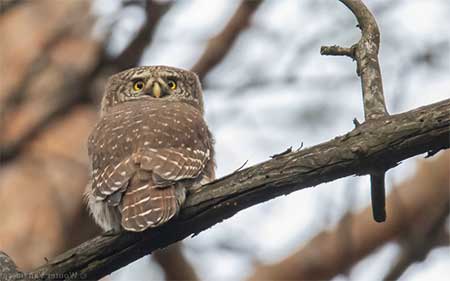 The Eurasian Pygmy Owl, or “Chevêchette d’Europe” in French, is the smallest in Europe. Despite its petite size, it has a big individuality that more than makes up for its stature.
The Eurasian Pygmy Owl, or “Chevêchette d’Europe” in French, is the smallest in Europe. Despite its petite size, it has a big individuality that more than makes up for its stature.
Physical Description and Identification
Eurasian Pygmy Owls measure a modest 15-19 cm length, with a wingspan of approximately 34-39 cm. They weigh a mere 50-70 grams. The owls are predominantly grey or reddish-brown, with streaks and spots of white on their bodies. The most striking feature is their yellow eyes, surrounded by delicate white eyebrows that give them a stern expression.
One of the unique and nice characteristics of this species is the presence of “false eyes” or eye spots on the back of their heads, presumably to confuse predators.
| Feature | Description |
|---|---|
| Size | Petite owl, measuring 15-19 cm long with a wingspan of 34-39 cm and weighing 50-70 grams. |
| Color | Predominantly grey or reddish-brown, with streaks and spots of white. |
| Eyes | Yellow eyes surrounded by delicate white eyebrows. |
| Unique Feature | “False eyes” or eye spots on the back of their heads. |
Habitat and Distribution in France
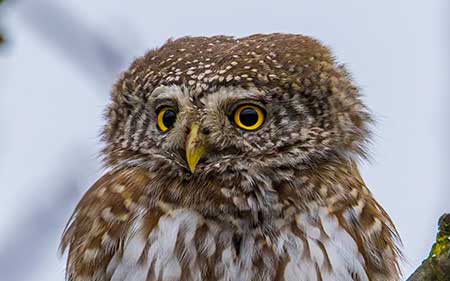 The Eurasian Pygmy Owl favors the thick, coniferous forests found in the mountainous regions of France, including the Pyrenees and the Alps. They are often found at elevations between 800 and 2,000 meters but can sometimes be spotted in lowland forests.
The Eurasian Pygmy Owl favors the thick, coniferous forests found in the mountainous regions of France, including the Pyrenees and the Alps. They are often found at elevations between 800 and 2,000 meters but can sometimes be spotted in lowland forests.
| Habitat | Description |
|---|---|
| General | Thick, coniferous forests in mountainous regions. |
| Specific Locations | Mostly found in the Pyrenees and the Alps, between 800 and 2,000 meters. |
Behavior and Diet
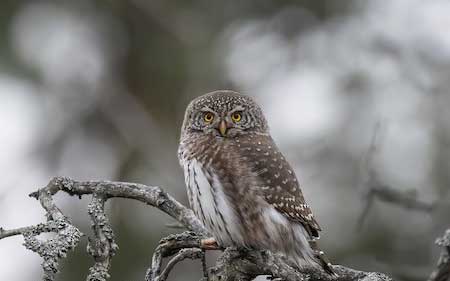 Eurasian Pygmy Owls are primarily crepuscular, meaning they are most active during the blue twilight hours of dawn and dusk. Their diet consists of small tiny mammals, birds, and insects. During the summer, they tend to feed heavily on insects, while in the cold winter, they switch to small mammals and birds.
Eurasian Pygmy Owls are primarily crepuscular, meaning they are most active during the blue twilight hours of dawn and dusk. Their diet consists of small tiny mammals, birds, and insects. During the summer, they tend to feed heavily on insects, while in the cold winter, they switch to small mammals and birds.
An exciting aspect of their behavior is their nesting habits. They don’t build their nests but instead, use old woodpecker holes or natural tree cavities.
| Behavior | Description |
|---|---|
| Activity | Crepuscular, most active during dawn and dusk. |
| Diet | Small mammals, birds, and insects. |
| Nesting | Uses old woodpecker holes or natural tree cavities for nesting. |
Should you hear a high-pitched whistle while hiking in the French mountains, take a moment to look around. You might spot the tiny yet impressive Eurasian Pygmy Owl.
Boreal Owl (Aegolius funereus)
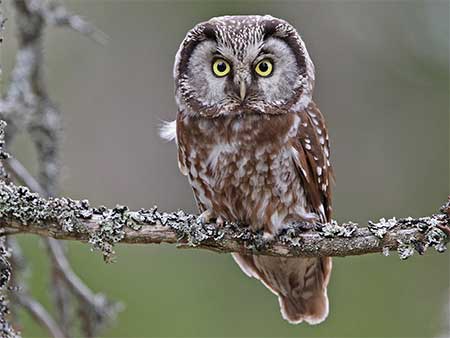 The Boreal Owl, also known as “Chouette de Tengmalm” in French, is another fascinating species of owl inhabiting the French countryside. It is a charming creature of the night, its mysterious persona perfectly fitting the darkened, peaceful forests it calls home.
The Boreal Owl, also known as “Chouette de Tengmalm” in French, is another fascinating species of owl inhabiting the French countryside. It is a charming creature of the night, its mysterious persona perfectly fitting the darkened, peaceful forests it calls home.
Physical Description and Identification
Boreal Owls are medium-sized, usually 22-27 cm long, with a 50-62 cm wingspan and a weight ranging from 100-200 grams. Their plumage is primarily brown with white spots, which provides excellent camouflage against tree barks.
A standout feature of Boreal Owls is their distinctive facial disc, which is white and rimmed with a thin, dark border. Their eyes are a beautiful yellow, while their beak is a contrasting black.
| Feature | Description |
|---|---|
| Size | Medium-sized owl, measuring 22-27 cm long with a 50-62 cm wingspan and weighing 100-200 grams. |
| Color | Brown plumage with white spots. |
| Eyes | Captivating yellow eyes. |
| Unique Feature | Distinctive white facial disc with a thin, dark border. |
Habitat and Distribution in France
 In France, Boreal Owls are primarily found in the mountainous regions, particularly the Jura, the Vosges, and the Alps. They prefer coniferous forests and are typically found in elevations ranging from 800 to 2,000 meters.
In France, Boreal Owls are primarily found in the mountainous regions, particularly the Jura, the Vosges, and the Alps. They prefer coniferous forests and are typically found in elevations ranging from 800 to 2,000 meters.
| Habitat | Description |
|---|---|
| General | Coniferous forests in mountainous regions. |
| Specific Locations | Primarily found in the Jura, the Vosges, and the Alps, between 800 and 2,000 meters. |
Behavior and Diet
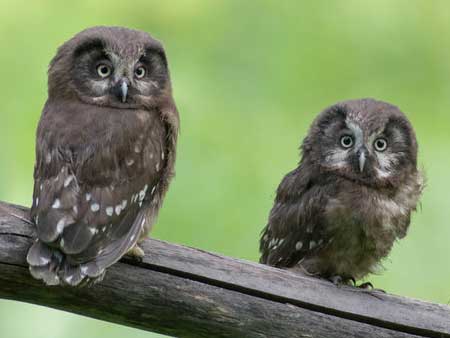 Boreal Owls are predominantly nocturnal creatures, actively hunting under the cover of darkness. They have a varied healthy diet that includes small mammals, birds, and insects. Voles, in particular, are a staple in their diet.
Boreal Owls are predominantly nocturnal creatures, actively hunting under the cover of darkness. They have a varied healthy diet that includes small mammals, birds, and insects. Voles, in particular, are a staple in their diet.
Like the Eurasian Pygmy Owl, Boreal Owls nest in tree cavities or old woodpecker holes. A fascinating aspect of their behavior is their ability to locate prey under snow or ground cover using their acute hearing.
| Behavior | Description |
|---|---|
| Activity | Nocturnal, most active during the night. |
| Diet | Small mammals, birds, and insects, with a preference for voles. |
| Nesting | Uses tree cavities or old woodpecker holes for nesting. |
| Hunting | Can locate prey under snow or ground cover using acute hearing. |
If you wander the forest trails of the French mountains at night, listen closely for the soft hoot of the elusive Boreal Owl, a true embodiment of the forest’s mystique.
Eurasian Scops Owls (Otus scops)
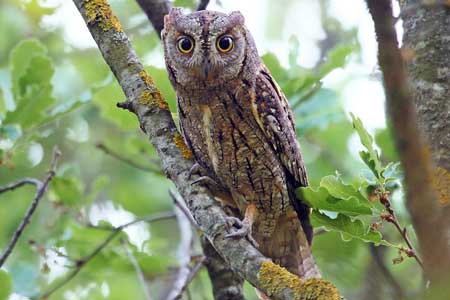 The Eurasian Scops Owl, or “Petit-duc Scops” as it is known in her native French, is one of the smaller species of owls found in France. Despite its small size, it is significant in the owl kingdom due to its unique characteristics and intriguing behavior.
The Eurasian Scops Owl, or “Petit-duc Scops” as it is known in her native French, is one of the smaller species of owls found in France. Despite its small size, it is significant in the owl kingdom due to its unique characteristics and intriguing behavior.
Physical Description and Identification
The Eurasian Scops Owl is a rather petite owl, with a body length ranging from 19-21 cm, a wingspan of 47-54 cm, and a weight between 60-135 grams. It dons a grey-brown plumage speckled with darker streaks and lighter spots.
The facial disc of the Eurasian Scops Owl is grey with a fine, dark rim. Its eyes are scary yellow, and it has a small, grey beak. A unique characteristic of this owl is its ear tufts, which, when raised, give the impression of pointy ears.
| Feature | Description |
|---|---|
| Size | Small owl, measuring 19-21 cm in length with a wingspan of 47-54 cm and weighing 60-135 grams. |
| Color | Grey-brown plumage with darker streaks and lighter spots. |
| Eyes | Yellow eyes. |
| Unique Feature | Ear tufts that, when raised, give the appearance of pointy ears. |
Habitat and Distribution in France
 Eurasian Scops Owls favor warmer climates and are predominantly found in southern France, particularly in open woodland, parks, and gardens.
Eurasian Scops Owls favor warmer climates and are predominantly found in southern France, particularly in open woodland, parks, and gardens.
| Habitat | Description |
|---|---|
| General | Open woodland, parks, and gardens. |
| Specific Locations | Primarily found in the southern parts of France. |
Behavior and Diet
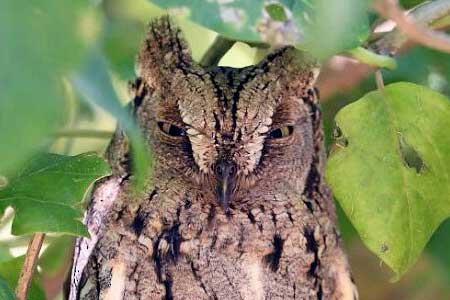 Eurasian Scops Owls are nocturnal and are known for their distinctive call, a repetitive, soft whistle that can be heard during spring and summer nights. Their diet mainly consists of small insects such as beetles and moths, but they are also known to prey on little mammals and birds.
Eurasian Scops Owls are nocturnal and are known for their distinctive call, a repetitive, soft whistle that can be heard during spring and summer nights. Their diet mainly consists of small insects such as beetles and moths, but they are also known to prey on little mammals and birds.
Nesting takes place in tree cavities or abandoned woodpecker holes. Intriguingly, the Eurasian Scops Owl has a fantastic ability to camouflage itself by mimicking the appearance of a tree branch.
| Behavior | Description |
|---|---|
| Activity | Nocturnal, most active during the night. |
| Diet | Mainly insects such as beetles, moths, small mammals, and birds. |
| Nesting | Uses tree cavities or old woodpecker holes for nesting. |
| Unique Behavior | Can mimic the appearance of a tree branch as a form of camouflage. |
Next time you’re in France’s southern regions pay close attention to the trees during the night. You might glimpse the Eurasian Scops Owl, a charming little owl with a character that outshines its size.
Eurasian Eagle Owl (Bubo bubo)
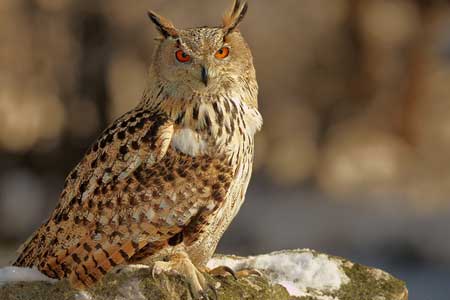 The Eurasian Eagle Owl, known as “Grand-duc d’Europe” in French, is one of the most striking owls in France and across much of Eurasia. Known for its bold, distinctive features and compelling behaviors, this owl is a magnificent specimen in the avian world.
The Eurasian Eagle Owl, known as “Grand-duc d’Europe” in French, is one of the most striking owls in France and across much of Eurasia. Known for its bold, distinctive features and compelling behaviors, this owl is a magnificent specimen in the avian world.
Physical Description and Identification
The Eurasian Eagle Owl is a large and powerfully built bird with a body length of 58 to 75 cm, a wingspan reaching up to 188 cm, and a weight from 1.5 to 4.2 kilograms.
A robust physique, prominent ear tufts, and large, bright orange eyes characterize this species. Its plumage is mainly mottled with a mix of earthy tones – browns, tans, and blacks, providing excellent camouflage against the backdrop of the rugged terrains it inhabits.
| Feature | Description |
|---|---|
| Size | Large owl, measuring 58-75 cm long with a wingspan of up to 188 cm and weighing 1.5-4.2 kilograms. |
| Color | Mottled brown, tan, and black plumage. |
| Eyes | Large, bright orange eyes. |
| Unique Feature | Prominent ear tufts. |
Habitat and Distribution in France
 The Eurasian Eagle Owl is found throughout much of France, except for the far north and the western coastal regions. It prefers habitats with rocky landscapes, open woodlands, and proximity to water bodies.
The Eurasian Eagle Owl is found throughout much of France, except for the far north and the western coastal regions. It prefers habitats with rocky landscapes, open woodlands, and proximity to water bodies.
| Habitat | Description |
|---|---|
| General | Rocky landscapes, open woodlands, and areas near water bodies. |
| Specific Locations | Widespread across much of France except for the far north and western coastal regions. |
Behavior and Diet
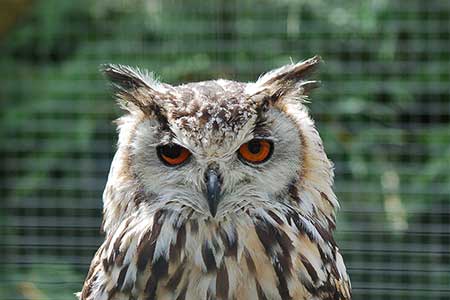 The Eurasian Eagle Owl is a nocturnal hunter, using its exceptional vision and hearing to locate and capture prey. Its diet is diverse, ranging from small mammals like rabbits and hares to larger prey like foxes and young deer.
The Eurasian Eagle Owl is a nocturnal hunter, using its exceptional vision and hearing to locate and capture prey. Its diet is diverse, ranging from small mammals like rabbits and hares to larger prey like foxes and young deer.
The nesting habits of the Eurasian Eagle Owl are unique; instead of building a traditional nest, it often chooses a ledge on a cliff or a flat ground to lay its eggs. It is also known for its deep, resonant hoot, a vocalization that can carry long distances.
| Behavior | Description |
|---|---|
| Activity | Nocturnal, most active during the night. |
| Diet | Diverse, ranging from small mammals like rabbits and hares to larger prey such as foxes and young deer. |
| Nesting | Prefers ledges on cliffs or flat ground for laying eggs. |
| Unique Behavior | Known for its deep, resonant hoot. |
Witnessing the Eurasian Eagle Owl in its natural habitat can be a truly awe-inspiring experience. Its captivating presence and mastery of survival in the wild make it one of France’s most remarkable members of the owl family.
Short-Eared Owl (Asio flammeus)
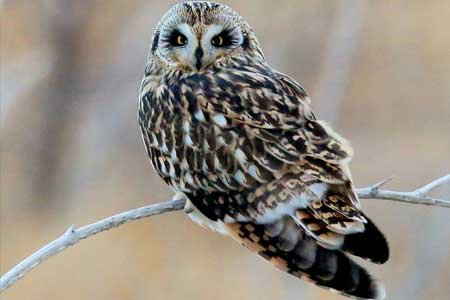 The Short-Eared Owl, or “Hibou des marais” as it’s referred to in French, is an intriguing species of owl whose distinguishing characteristics and unique habits make it a standout amongst the owls of France.
The Short-Eared Owl, or “Hibou des marais” as it’s referred to in French, is an intriguing species of owl whose distinguishing characteristics and unique habits make it a standout amongst the owls of France.
Physical Description and Identification
The Short-Eared Owl is a beautiful medium-sized bird with a body length that typically ranges from 34 to 43 cm, a wingspan of about 85 to 110 cm, and an average weight between 206 to 475 grams.
This owl is characterized by its short ear tufts, often flattened and barely visible. The overall plumage is mottled brown and buff, with darker streaks on the upper parts and pale underparts. Its striking yellow eyes, rimmed with black, contribute to its distinct facial disk.
| Feature | Description |
|---|---|
| Size | Medium-sized owl, with body length of 34-43 cm, wingspan of 85-110 cm, and weight between 206-475 grams. |
| Color | Mottled brown and buff plumage with darker streaks on upper parts and pale under details. |
| Eyes | Bright yellow eyes rimmed with black. |
| Unique Feature | Short, often flattened ear tufts. |
Habitat and Distribution in France
 The Short-Eared Owl favors open habitats such as marshes, meadows, and grasslands in France. While it is less widely distributed than other owl species, it can be found primarily in the northeastern regions and along the Atlantic coast.
The Short-Eared Owl favors open habitats such as marshes, meadows, and grasslands in France. While it is less widely distributed than other owl species, it can be found primarily in the northeastern regions and along the Atlantic coast.
| Habitat | Description |
|---|---|
| General | Open habitats such as marshes, meadows, and grasslands. |
| Specific Locations | Predominantly found in northeastern France and along the Atlantic coast. |
Behavior and Diet
 As one of the few owl species commonly active during sunny days, particularly at dawn and dusk, the Short-Eared Owl is a skilled hunter. It feeds primarily on small mammals, particularly voles, and takes birds and insects when available.
As one of the few owl species commonly active during sunny days, particularly at dawn and dusk, the Short-Eared Owl is a skilled hunter. It feeds primarily on small mammals, particularly voles, and takes birds and insects when available.
Regarding nesting, the Short-Eared Owl opts for a straightforward approach. It nests on the ground, often in dense vegetation, laying 4-7 eggs. Its flight is characterized by stiff, shallow wingbeats, often interspersed with glides and wing-clapping during courtship displays.
| Behavior | Description |
|---|---|
| Activity | Diurnal, most active at dawn and dusk. |
| Diet | Predominantly small mammals, particularly voles, but also birds and insects. |
| Nesting | Nests on the ground in dense vegetation. |
| Unique Behavior | Characteristic stiff, shallow wingbeats and wing-clapping in courtship displays. |
The Short-Eared Owl’s distinct behavior and physical features make it an intriguing addition to the avian biodiversity of France. Whether in the marshes or grasslands, this owl’s presence truly enhances the landscape.
Long-Eared Owls (Asio otus)
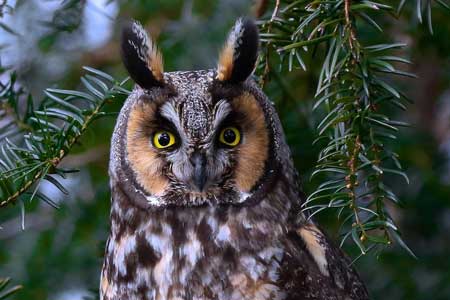 The Long-Eared Owl, or “Hibou moyen-duc” in French, is a captivating species that combines a majestic appearance with fascinating behavioral traits. We will examine its physical attributes, habitats, and diet.
The Long-Eared Owl, or “Hibou moyen-duc” in French, is a captivating species that combines a majestic appearance with fascinating behavioral traits. We will examine its physical attributes, habitats, and diet.
Physical Description and Identification
The Long-Eared Owl is a medium-sized owl, averaging 31 to 40 cm in body length, with a wingspan ranging from 86 to 100 cm. The weight of this owl species typically lies between 200 and 435 grams.
The distinguishing feature of this owl, as suggested by its name, is its long ear tufts, which are raised when the bird is alert. The plumage combines brown, grey, and buff, with darker streaks and bars. Its facial disk is highlighted by bright orange eyes that offer a stark contrast against the darker feathers.
| Feature | Description |
|---|---|
| Size | Medium-sized owl, with a body length of 31-40 cm, a wingspan of 86-100 cm, and weight between 200-435 grams. |
| Color | Brown, grey, and buff plumage with darker streaks and bars. |
| Eyes | Bright orange eyes. |
| Unique Feature | Long, prominent ear tufts that are raised when alert. |
Habitat and Distribution in France
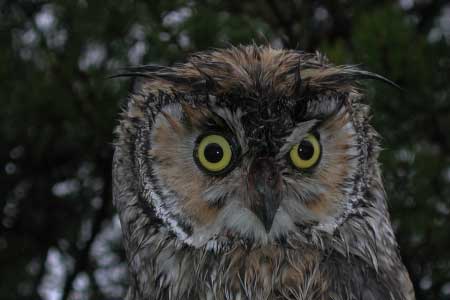 The Long-Eared Owl inhabits various environments, from dense forests to open country, always near some woodland. It is widely distributed in France in most regions except for the extreme north and south.
The Long-Eared Owl inhabits various environments, from dense forests to open country, always near some woodland. It is widely distributed in France in most regions except for the extreme north and south.
| Habitat | Description |
|---|---|
| General | Variety of environments, always close to woodland. |
| Specific Locations | Found in most regions of France except for the extreme north and south. |
Behavior and Diet
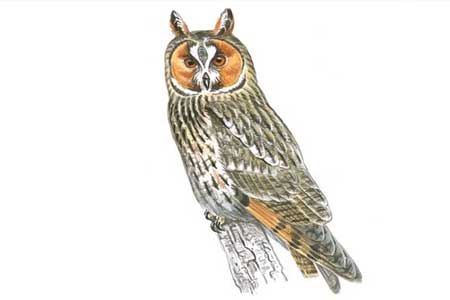 The Long-Eared Owl is primarily a nocturnal creature. It feeds on a diet rich in small mammals, especially voles and mice, but also occasionally preys on birds and insects.
The Long-Eared Owl is primarily a nocturnal creature. It feeds on a diet rich in small mammals, especially voles and mice, but also occasionally preys on birds and insects.
Unlike many owl species, the Long-Eared Owl is a communal rooster during the non-breeding season, often forming groups of up to a dozen birds. They nest in old crow or squirrel nests rather than creating their own, typically laying 4-5 eggs.
| Behavior | Description |
|---|---|
| Activity | Nocturnal. |
| Diet | Predominantly small mammals, especially voles and mice, but also birds and insects. |
| Nesting | Utilizes old crow or squirrel nests. A communal rooster outside the breeding season. |
| Unique Behavior | Forms communal roosts of up to a dozen birds outside the breeding season. |
The Long-Eared Owl’s distinctive characteristics, both in its physical features and its behavior, make it an integral part of France’s rich avian life. Their communal roosting habit, in particular, is a sight to behold, adding to the charm and allure of this remarkable species.
Little Owl (Athene noctua)
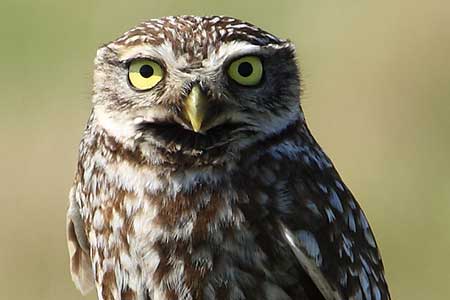 The last species we will delve into within this comprehensive guide is the Little Owl, also known as “Chevêche d’Athéna” in France. Learn more about its distinguishing physical attributes, preferred habitats, and diet.
The last species we will delve into within this comprehensive guide is the Little Owl, also known as “Chevêche d’Athéna” in France. Learn more about its distinguishing physical attributes, preferred habitats, and diet.
Physical Description and Identification
The Little Owl is aptly named for its petite stature, measuring between 21 to 23 cm in body length and boasting a wingspan of approximately 55 cm. A fully grown Little Owl weighs between 160 and 220 grams.
Its plumage is predominantly grayish-brown, mottled with white spots, and its underparts are paler with streaks of dark brown. The Little Owl’s facial disk is distinctive, with white eyebrows and a white “chinstrap” that contrasts against its otherwise dark face. Its yellow eyes add to its appealing countenance.
| Feature | Description |
|---|---|
| Size | Small, with a body length of 21-23 cm, a wingspan of 55 cm, and weight between 160-220 grams. |
| Color | Predominantly grayish-brown plumage, mottled with white spots. Pale underparts with dark brown streaks. |
| Eyes | Bright yellow eyes. |
| Unique Feature | Distinctive white eyebrows and “chinstrap”. |
Habitat and Distribution in France
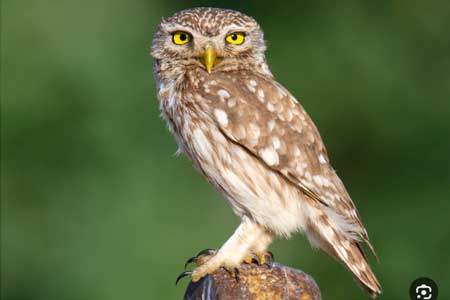 The Little Owl has adapted to various habitats, including farmland, orchards, parks, and even suburban areas, as long as there are suitable cavities for nesting. It is most commonly found in the rainy and warmer southern regions of France.
The Little Owl has adapted to various habitats, including farmland, orchards, parks, and even suburban areas, as long as there are suitable cavities for nesting. It is most commonly found in the rainy and warmer southern regions of France.
| Habitat | Description |
|---|---|
| General | Variety of environments, including farmland, orchards, parks, and suburban areas. |
| Specific Locations | Most commonly found in the warmer, southern regions of France. |
Behavior and Diet
 Unlike most owl species, the Little Owl is not strictly nocturnal but is active during daylight hours, especially around dawn and dusk. It feeds primarily on invertebrates such as insects and spiders but also takes small mammals, birds, and amphibians.
Unlike most owl species, the Little Owl is not strictly nocturnal but is active during daylight hours, especially around dawn and dusk. It feeds primarily on invertebrates such as insects and spiders but also takes small mammals, birds, and amphibians.
Little Owls are solitary and territorial. Their nests are often found in tree holes, rock crevices, or old buildings, where the female lays 3-5 eggs.
| Behavior | Description |
|---|---|
| Activity | Active during daylight hours, especially around dawn and dusk. |
| Diet | Predominantly invertebrates, but also small mammals, birds, and amphibians. |
| Nesting | Utilizes tree holes, rock crevices, or old buildings. |
| Unique Behavior | Solitary and territorial. |
In conclusion, the Little Owl is a unique and captivating species, with its distinctive physical characteristics and broad habitat range. The Little Owl certainly adds to France’s rich tapestry of owls, whether it’s the bird’s interesting diurnal behavior or its adaptability to different environments.
Tawny Owl (Strix aluco)
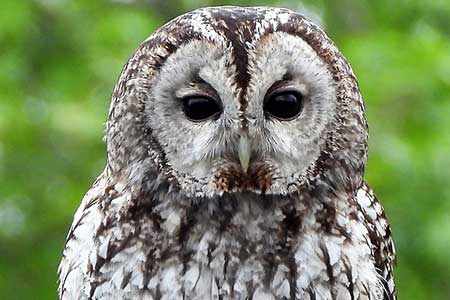 The Tawny Owl, or “Chouette hulotte” as it is known in France, is another intriguing species worth exploring. We’ll examine its physical characteristics, habitats in France, behavioral tendencies, and diet.
The Tawny Owl, or “Chouette hulotte” as it is known in France, is another intriguing species worth exploring. We’ll examine its physical characteristics, habitats in France, behavioral tendencies, and diet.
Physical Description and Identification
The Tawny Owl stands out due to its moderate size, with body lengths ranging from 37 to 43 cm and a wingspan extending from 81 to 96 cm. The bird typically weighs between 300 and 580 grams.
Its plumage varies between rich tawny-brown and pale grey, with a mottled, darker pattern. The facial disc is comparatively plain, framed by a thin, dark rim. Notably, its dark eyes are a significant identifying feature.
| Feature | Description |
|---|---|
| Size | Moderate, with body lengths of 37-43 cm, a wingspan of 81-96 cm, and weight between 300-580 grams. |
| Color | Plumage varies from tawny-brown to pale grey with a mottled, darker pattern. |
| Eyes | Dark eyes. |
| Unique Feature | Comparatively plain facial disc with a thin, dark rim. |
Habitat and Distribution in France
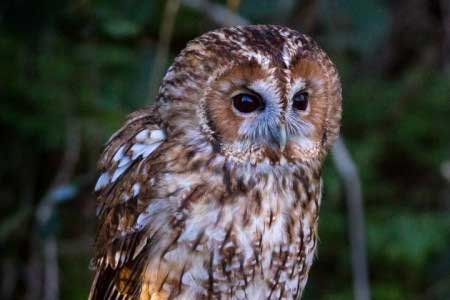 The Tawny Owl is a versatile bird and lives in a very wide variety of habitats. These include deciduous and mixed forests, parks, gardens, and urban areas. It is widespread in France but less common in the Mediterranean region.
The Tawny Owl is a versatile bird and lives in a very wide variety of habitats. These include deciduous and mixed forests, parks, gardens, and urban areas. It is widespread in France but less common in the Mediterranean region.
| Habitat | Description |
|---|---|
| General | Versatile, inhabits deciduous and mixed forests, parks, gardens, and urban areas. |
| Specific Locations | Widespread across France, less common in the Mediterranean region. |
Behavior and Diet
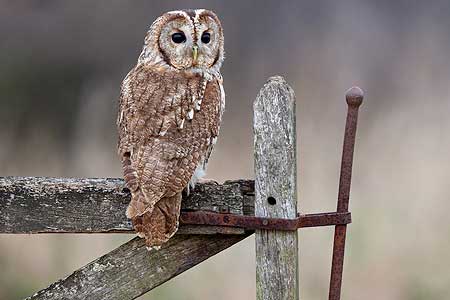 Tawny Owls are nocturnal creatures, active mainly during the night. Their diet is diverse, predominantly featuring small mammals like mice and voles, but also including birds, insects, and amphibians.
Tawny Owls are nocturnal creatures, active mainly during the night. Their diet is diverse, predominantly featuring small mammals like mice and voles, but also including birds, insects, and amphibians.
These owls are known for their distinctive hooting calls, often associated with the quintessential “owl sound.” They are generally sedentary and territorial, with nests usually found in tree cavities or old crow’s nests.
| Behavior | Description |
|---|---|
| Activity | Nocturnal, active mainly during the night. |
| Diet | Predominantly small mammals, but also birds, insects, and amphibians. |
| Nesting | Utilizes tree cavities or old crow’s nests. |
| Unique Behavior | Known for its distinctive hooting calls. |
In essence, the Tawny Owl is a fascinating species. Its nocturnal habits and distinctive hooting call make it a symbol of the night. Its ability to adapt to various habitats, including urban areas, exemplifies its resilience and contributes to its widespread distribution across France.
How to Identify Owls: Key Features and Tips
Before diving into the details of each owl species found in France, it’s beneficial to understand the key features used for owl identification and some helpful tips for observing these magnificent creatures in their natural habitats.
Physical Features Used for Owl Identification
Despite their shared family, owls exhibit various physical characteristics that can help in their identification. Each species has distinct traits, from its size and shape to its unique feather patterns and eye colors. Here are some primary features to focus on:
Size and Shape: The size of an owl can significantly vary from the petite Eurasian Pygmy Owl to the grandeur of the Eurasian Eagle Owl. The body shape can also provide clues. For instance, some owls have ear tufts, like the Long-Eared Owl, while others have round heads, like the Barn Owl.
Feather Patterns and Colours: The plumage of owls is for beauty and excellent camouflage. Some owls have distinct patterns or colors that can aid in their identification.
Eyes and Beak: The eye color of owls can vary from one species to another, ranging from bright yellow to dark brown. The shape and color of their beak can also provide valuable identification information.
| Identification Feature | Description |
|---|---|
| Size and shape | Observe the overall size and shape of the owl, including any unique physical characteristics such as ear tufts or round heads. |
| Feather Patterns and Colours | Look for distinctive feather patterns or colors that may help identify the species. |
| Eyes and beak | Note the eye color and the shape and color of the beak. |
Tips for Observing Owls in the Wild
Observing owls in their natural habitats can be a rewarding experience. However, as most owl species are nocturnal and elusive, it requires patience, respect, and a bit of know-how. Here are some tips to enhance your owl-watching endeavors:
Timing is Key: Most owls are active during the twilight hours of dawn and dusk. This period, known as “crepuscular,” is your best bet for observing these fascinating creatures.
Quiet Observation: Owls have keen hearing, and loud noise can scare them off. Move slowly, keep noise levels to a minimum, and observe from a respectful distance.
Location: Knowing the preferred habitat of the owl species you’re interested in can significantly increase your chances of spotting one. Refer to our habitat guide above for specifics.
Use of Binoculars: A good pair of binoculars can significantly enhance your observation capabilities, especially since owls can be hard to spot due to their natural camouflage and tendency to perch high in trees.
| Tips | Description |
|---|---|
| Timing | Most owls are active during the twilight hours of dawn and dusk. |
| Quiet Observation | Keep noise levels to a minimum and observe from a respectful distance. |
| Location | Know the preferred habitat of the owl species you’re interested in. |
| Use of Binoculars | A good pair of binoculars can enhance your observation capabilities. |
Armed with this knowledge, you’ll be well-prepared to identify and appreciate the diverse owl species found in France. In the upcoming sections, we’ll delve into each owl species’ specifics, providing detailed information to help you identify them accurately.
Conclusion: The Joy of Owl Spotting in France
In our journey through the nocturnal realm of owls in France, we’ve ventured through the diverse world of these compelling creatures. Each species, from the Barn Owl to the Tawny Owl, plays a crucial role in maintaining the health of local ecosystems. They control pest populations and contribute to the richness of the biodiversity in the region.
Engaging in the activity of owl spotting provides a unique opportunity to appreciate these wonders of nature and broadens our understanding of the intricate web of life. However, we must approach this activity with respect and consideration for these magnificent creatures and their habitats. Observing from a safe distance and minimizing disturbance is essential to responsible wildlife viewing.
Let us treasure the marvels that these nocturnal creatures present us. Their captivating calls at night, precision in flight, and vital roles in our ecosystems are all worth our admiration and respect.
References
For those interested in further exploration of owls in France, consider the following books available on Amazon:
- Owls of Europe by Heimo Mikkola
- The Secret Life of Owls by John Lewis-Stempel
- Birds of France: Pocket Nature by DK

Margarita Alexieva is a highly respected figure in the realm of journalism. Her diverse background spans numerous newspapers and magazines, where she’s crafted a multitude of pieces ranging from investigative journalism to enlightening editorials. Not only confined to print media, Margarita’s media experience also encompasses regional television stations, where her powerful storytelling abilities have resonated with a wide audience. As a dedicated journalist, Margarita’s work consistently reflects her commitment to accuracy, fairness, and an unwavering dedication to shedding light on vital issues. Her significant contributions to the media landscape continue to inform, inspire, and engage readers and viewers alike.

Interesting article! The Tawny Owl’s hooting call can vary regionally, with some exciting dialects appearing across France
I’ve had the privilege of spotting the Short-Eared Owl in the wild, and it’s a truly spectacular sight! Worth mentioning is their unique flying style, often described as ‘moth-like.
Nice read! Despite their preference for rural areas, I’ve found that Barn Owls have adapted quite well to urban environments in France